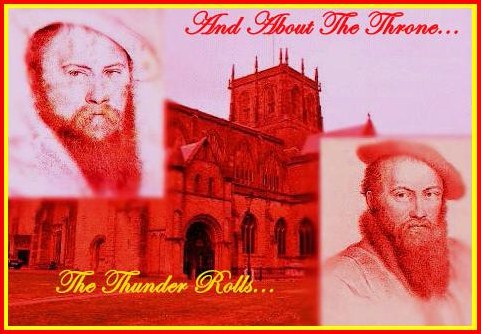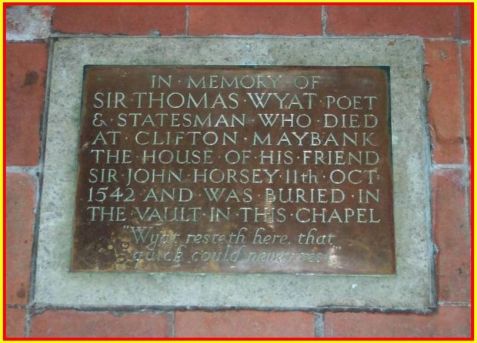Extract from 'History and Antiquities of Sherborne in the County of Dorset'
By John Hutchins MA
1815
pg 111
Being sent by the King to Falmouth, to conduct Montmorency, the Imperial Ambassador, to London, from an excess of zeal to please the King, he made more expedition than was necessary, riding hard in a very hot season, and died of a violent fever here, and was buried in the great church, 1541. Epitaphs for him were written by Henry Howard, the Earl of Surrey, and other learned men, but none put up.
Of The Same
Epitaph of Sir Thomas Wyatt's Death
by Henry Howard, Earl of Surrey
Wyatt resteth here, that quick could never rest :
Whose heavenly gifts increased by disdain ;
And virtue sank the deeper in his breast :
Such profit he by envy could obtain.
A head, where wisdom mysteries did frame ;
Whose hammers beat still in that lively brain,
As on a stithe, where that some work of fame
Was daily wrought, to turn to Britain's gain.
A visage stern, and mild ; where both did grow
Vice to contemn, in virtue to rejoice :
Amid great storms, whom grace assured so,
To live upright, and smile at fortune's choice.
A hand, that taught what might be said in rhyme ;
That reft Chaucer the glory of his wit.
A mark, the which (unperfected for time)
Some may approach, but never none shall hit.
A tongue that serv'd in foreign realms his king ;
Whose courteous talk to virtue did inflame
Each noble heart ; a worthy guide to bring
Our English youth by travail unto fame.
An eye, whose judgment none effect could blind,
Friends to allure, and foes to reconcile ;
Whose piercing look did represent a mind
With virtue fraught, reposed, void of guile.
A heart, where dread was never so imprest
To hide the thought that might the truth advance ;
In neither fortune loft, nor yet represt,
To swell in wealth, or yield unto mischance.
A valiant corpse, where force and beauty met :
Happy, alas! too happy, but for foes,
Lived, and ran the race that nature set ;
Of manhood's shape, where she the mould did lose.
But to the heavens that simple soul is fled,
Which left, with such as covet Christ to know,
Witness of faith, that never shall be dead ;
Sent for our health, but not received so.
Thus for our guilt this jewel have we lost ;
The earth his bones, the heaven possess his ghost.
He left by his wife Elizabeth, daughter of Thomas Brooke, Lord Cobham, one son of his own name, beheaded for a rebellion in queen Mary’s reign. It has been conjectured, that, if Sir Thomas Wyatt was not buried in the Horsey vault, his remains were nearly opposite the great west door on the south side towards the font, in a very strong leaden coffin immediately under the floor. In a line with this, on the north side of the door, the mason employed about the church says there is an ancient stone coffin, which is not known to have been opened.
Unfortunately, there had been no visible signs of the memorial stone until 1945. Although thanks to the descendants of Sir Thomas Wyatt the situation was repaired. A tablet set in Hopton Wood stone has been let into the floor of the Wickham Chapel, close to the Horsey Monument, with this beautifully-lettered inscription:
"In memory of Sir Thomas Wyatt,
Poet and Statesman,
who died at Clifton Maybank,
the house of his friend, Sir John Horsey,
11th of October 1542,
and was buried in the vault of this chapel"
"Wyat resteth here, that
quick could never rest" |

